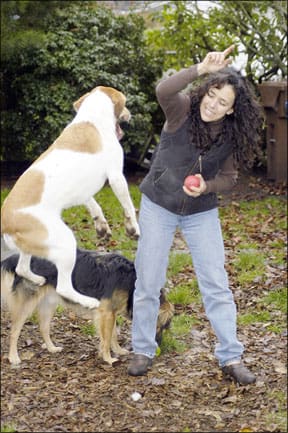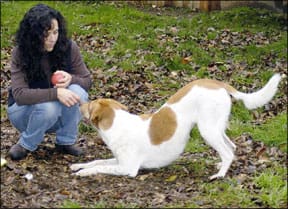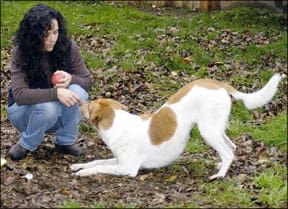Training the family dog can be difficult and trying at times, but it’s important to stay positive, have fun, and keep practicing, says Tacoma, Washington-based trainer Kathy Sdao, an associate Certified Applied Animal Behaviorist (CAAB) who has worked as a full-time animal trainer for the past 23 years.
As a graduate student at the University of Hawaii in the 1980s, Sdao (pronounced suh-DAY-oh) was part of a team that trained dolphins to solve complex cognitive puzzles. After receiving a master’s degree in experimental psychology, she worked for the U.S. Navy to train dolphins for defense-related open-ocean tasks. Next, Sdao worked as a marine mammal trainer at the Point Defiance Zoo and Aquarium in Tacoma, Washington. There she expanded her training skills by working with beluga whales, walruses, porpoises, sea lions, polar bears, and otters. Years later, Sdao and another zookeeper left their jobs to create Tacoma’s first dog daycare facility, Puget Hound Daycare. This is where Sdao began teaching group classes for pet owners.

Photo by Jon Smith
288
Since leaving Puget Hound in 1999, Sdao has been lecturing throughout the U.S. and Europe on operant conditioning, sharing her passion for the science of training and the awesome power of clicker training. Sdao lives in Tacoma with two rescue dogs.
I first met Sdao a decade ago at one of the Association of Pet Dog Trainer’s annual conferences, where she was presenting a talk about the use of positive training and enrichment for rehabilitating aggressive animals. She talked about dogs, but also gave a detailed case history of her work with an aggressive juvenile walrus named E.T. at the Point Defiance Zoo and Aquarium. Her video footage of E.T.’s transformation from a ton of very reactive, dangerous muscle and teeth to a well-behaved, affectionate walrus was astounding. Positive techniques, Sdao says, are incredibly powerful.
I asked Sdao if she could contribute to our special section this month on training fun and games. Here is our conversation about making training more enjoyable for dogs and people.
What can people do to make training more fun for their dogs?
For one, they can stay positive, and avoid doing anything that is punishing for the dog that is, painful or even just annoying enough to cause behavior suppression and anxiety. Even a small amount of aversive things mixed into an otherwise very positive training program can poison a dog’s willingness and interest in training. Training can be negatively affected by even very infrequent leash pops or verbal reprimands. A simple unhappy sigh or scowl which even positive trainers will do from time to time can affect training, even if they are fairly mild.
These aversive things can also decrease the value of your reinforcers, which has more serious consequences to your training program. You can inadvertently turn your reinforcers into punishers if you’re not careful. We generally think of food, toys, and praise as being immutably reinforcing for dogs but you can actually wreck that by associating those things with punishment. Once you have a dog who no longer trusts food or praise, you’ll find that your training really slows down . . . and it’s easy to blame the dog for this, instead of the fact that your reinforcers are not so reinforcing any more.
How can this happen? A good example is when food is followed quickly by something the dog finds scary: e.g., peanut butter is used to lure a dog into getting his nails trimmed; liver treats are thrown into a crate to lure a dog in (where he will spend the next eight hours); cookies are used to coax the dog onto a teeter in agility. These experiences of reinforcement (food) followed almost immediately by a punisher will cause the food to be suspect. It’s as if the food starts to have strings attached. (Then students will tell me they have a dog who isn’t motivated by food . . . Sigh.)
How can a person tell when they are presenting something that is aversive for the dog?
Aversives are easy to identify in the behavior laboratory: the rat runs out of the Skinner box (its real name is operant conditioning chamber) when shocked by an electrified floor grid; the chimp looks for ways to leave the cage if threatened. In training, when our dogs are on leash with us and they can’t physically leave, they often mentally check out.
I see lots of dogs who look confused, or show low-level signs of stress, by turning away from their handlers, licking their lips, sniffing the ground. Detaching from their trainers tells us that the training is really not that much fun for them or it might even be quite icky for them. It doesn’t indicate that they are stupid or that they are just not paying attention. Frustrated handlers will often say “My dog is not paying attention!” The dog may not be paying attention because he would prefer to be somewhere else.
Sometimes, though, this is less about the handler being aversive and more about the rest of the dog’s environment being so much more appealing than the handler. When people say, My dog is so easily distracted, it’s really not about a distractible dog; it’s actually a symptom of something bigger. It’s about the handler not being very reinforcing.
Norwegian clicker trainers Morten Egtvedt and Cecile Koeste, owners of Canis Clickertraining Academy and very successful obedience competitors, recently put it this way: If you are not paying well enough, your dog just might take a job with another firm that is offering a better rate of pay. Dogs are going to do whatever is most worthwhile for them, and if you are not more fun than chasing a squirrel or investigating something smelly, you just might lose that canine employee.
What are some things people can do to make themselves more enjoyable for their dogs?
One thing that marine mammal trainers do a lot, to great effect, is to intentionally build up the list of things that can serve as secondary reinforcers. Food is a primary reinforcer; animals don’t have to be taught to like food. But if you have only food as a reinforcer if food is the only thing that motivates an animal you have nothing to work with if the animal is not hungry or is sick.

jonsmithphotos.com
Marine mammal trainers intentionally develop a number of other things that the animals enjoy: certain toys, certain types of touching or scratching, having a stream of water sprayed on their tongues. These things may not start out as inherently enjoyable or reinforcing in and of themselves, but if you consistently, in a careful way, associate them with other reinforcers, you can transform them into reinforcers. Then you have even more things to use to motivate your dog to learn and to behave how you want him to.
What about a handlers body language, posture and facial expressions? I see many people who frown or get stern when they work with their dogs . . .
I heard someone else say this, and I like to repeat it: Train like no one is watching you. I find that when people are alone, they are much more relaxed, they are looser, their shoulders are down, they breathe evenly, the leash is loose . . . but as soon as they realize that another human is watching whether it’s an instructor, co-trainer, family member, friend they really tense up, which makes it difficult to stay in the moment with the dog and observe and respond to him.
Worrying about who is watching us is a natural primate thing, but it’s counterproductive in dog training. Allow yourself to relax and remember that it’s really about teaching the dog, not performing for whomever is watching you. I reinforce students in my classes for laughing when they are having fun. Most of my students have to be encouraged to be more animated and relaxed.
That said, you don’t have to dance around and cheer to be a good trainer. There are very good trainers who are quite still and quiet. And there are some trainers who are very animated and would seem to be very exciting for their dogs, but who have such bad timing or are so distracting to their dogs that they actually make it harder for the dog to learn. It’s a fine line. The most important thing is to really watch your dog and reinforce as quickly and appropriately as you can.
What are some other things people can do to keep their training sessions enjoyable for the dog?
I try to teach people to keep their expectations reasonable. You shouldn’t expect to be able to get your dog to make giant changes in his behavior in any one training session.
It’s sort of like going to the gym and doing a set of curls. How much do you expect your biceps to change in each session? Do you really expect them to look different when you come out from when you went in? Not much. But you do understand that after lots of short sessions of doing curls at the gym you’ll have nice biceps.
Understand, too, that your dog may improve only negligibly in any given training session. I’ll test my students on this by asking, “What’s your goal for this training session?” If they answer some big chunk of behavior change “I’d like to teach him to come and sit straight in front of me!” I tell them that their expectations may be too high; it may not be real fun. Let’s do something more reasonable, or it’s going to be a real grind for the dog.
I use the gym analogy to illustrate the importance of short sessions, too. You wouldn’t do curls continuously until your biceps grew visibly! No, you do a set until your muscles are just beginning to be fatigued, then you take a break and drink some water. Then you do another set, and then do something else. You slowly build strength over time. Dog training should be just the same: frequent, short, fun sessions. Over time, you’ll see great improvement.
Another thing: Many people suggest that you should try to always end a training session on a good note. I don’t think this is always a good idea. Many of us start a training session, and things start out well. But then we hit a point where things start going awry. If we persist in an effort to end on a good note, oftentimes we just make things worse.
If the dog starts showing signs of checking out and getting frustrated, sometimes it’s better to just stop the session. I’d suggest stopping not angrily, just stopping putting the dog safely away somewhere, and trying to figure out what went wrong, rather than persisting in a session that, to any objective observer, is not going well.
I hear owners say things like this: “Positive training is all well and good in my backyard, but what about using it in the real world?” Can we ever really be more interesting and motivating than all of the distractions out there?
I would love to promote the Premack principle and its uses. Few trainers really understand the full power of its potential and it’s been so incredibly powerful for me as a trainer in real-world situations. The concept is that high-probability behavior will reinforce low-probability behavior. It’s so dry, but it’s also so practical. Let me explain:
Just about all the behaviors we want our dogs to do could be considered low-probability behavior. That means that the things we want them to do walk or sit quietly at our sides no matter what is going on around them, ignore other distractions in the world and pay attention mostly to us are things that they would be fairly unlikely to do on their own, if there were no leashes and no fences.
All those things that dogs would like to do most at any given moment go sniff that pole, pee on those bushes, run and look for squirrels, greet that other dog those are high-probability behaviors. If you took off the leash, the probability is very high that your dog would go do those things. We ordinarily call those things distractions. But consider this: Those things are also by definition reinforcements. The dog really enjoys them and wants them; they could be amazing jackpots in our training, if we structure our training really well.
Approached the right way, you can transform distractions into reinforcers. All you have to do is show the dog that if he does a little bit of your low-probability behavior, you will let him go sniff that pole, go pee on those bushes, run and look for squirrels whatever that dog is most apt to do right then.
We want dogs to pay attention to us and ignore everything else. I tell people to stop trying to get their dogs attention and, instead, to brainwash the dog into realizing that the way to get access to all the things he wants is to pay attention to you. I don’t even teach my dogs to pay attention and make eye contact with me anymore; I found it redundant after I realized that if I just gave frequent, consistent, meaningful reinforcement, my dogs will naturally pay more attention to me. They aren’t going to ignore me, because I have convinced them I am the way to get to the things they want in the world.
Many people, even very experienced trainers, knock their heads against the wall when they are trying to figure out how to get dogs to walk away from chasing a squirrel. I tell them, let’s figure out how to use squirrels in your training program. It takes some creativity; I know that. But if you can do it properly, it expands your ability to reinforce so much; it can take you so much farther than that cookie you have in your pocket.






